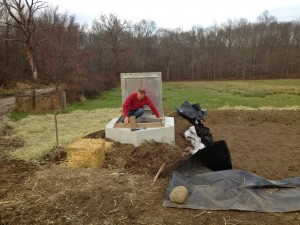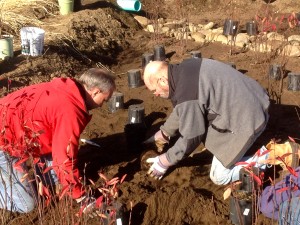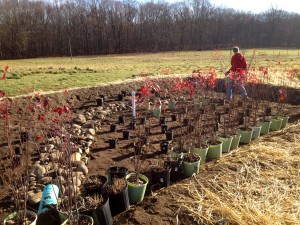
Last week CLEAR’s NEMO Program broke ground on a new monitoring project focused on the Low Impact Development (LID) practice of bioretention. Bioretention is the practice of reducing the quantity, and increasing the quality, of runoff by directing it to a depression filled with plants. This is the same concept as the more widely recognized rain garden, which is just a small bioretention area with a little less engineering and a much sexier name. (Check out the new NEMO Rain Garden website).
The project, funded by the federal/state partnership Long Island Sound Study, is located on the agricultural half of the UConn campus. The bioretention cell (heretofore called “cell” because bioretention is hard to type) is about 500 square feet in size, and drains an area of pavement about 10,000 square feet. Impervious surfaces like pavement and rooftops prevent percolation of rainfall into the soil, creating stormwater runoff and its associated problems of flooding, erosion and pollution. As can be seen in the photos, the cell is planted with a three different types of native plants (about 120 in this case), which help to reduce the volume of runoff through evapotranspiration (last time we’ll use that word) and process pollutants through biological uptake.
The project is to monitor how effective the cell is at removing nitrogen (N), a common nutrient that can cause a number of health and environmental problems when overabundant in drinking and surface waters. N pollution has been demonstrated to be a major driver of the problem of low oxygen levels in Long Island Sound, sometimes called hypoxia. Because of this, the entire lower Long Island Sound watershed, which includes almost all of Connecticut, is subject to a federal/state Clean Water Act provision that creates an allowable “budget” for N entering the Sound. This research will help determine if LID strategies like bioretention can help meet this budget.
The cell will be monitored for one year. If you want to know more, contact The Bioretention Man, Dr. Mike Dietz of CLEAR/NEMO, who has been camping out and living in the cell for the past two weeks. (We are hoping that if he gets enough phone calls and emails, he eventually will go home to his wife and daughter).

